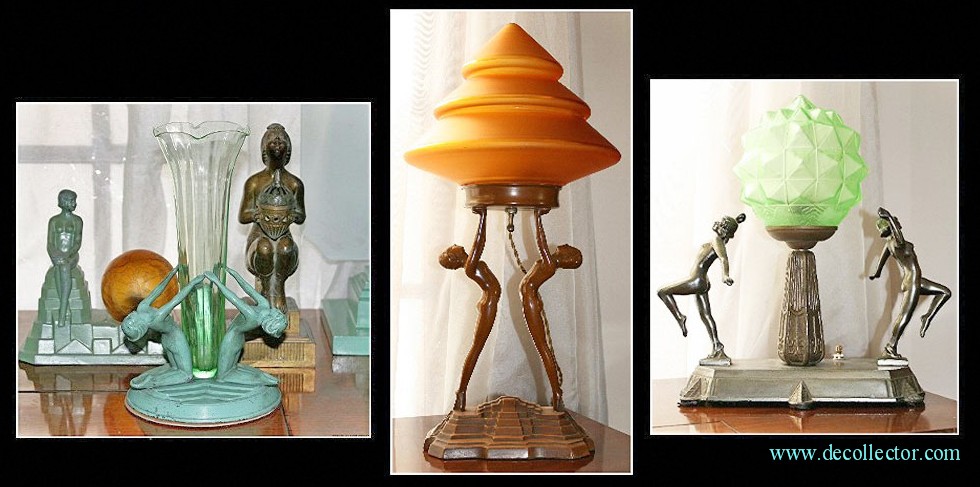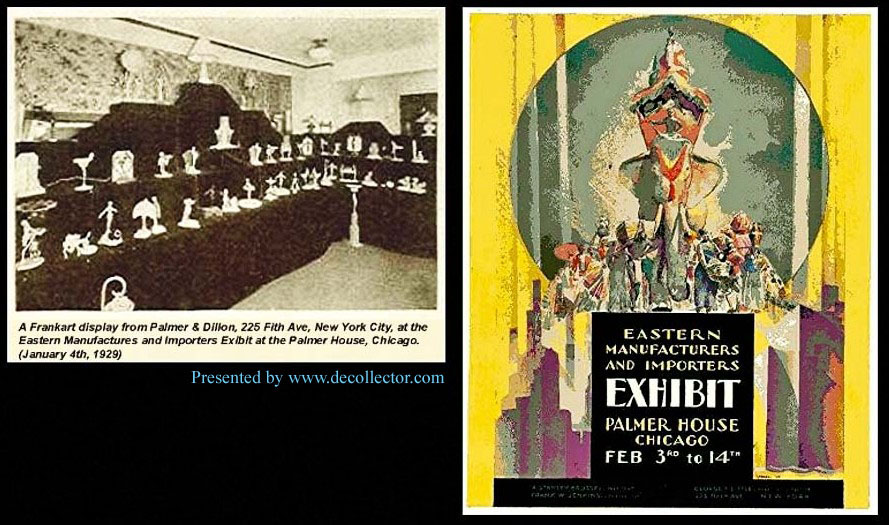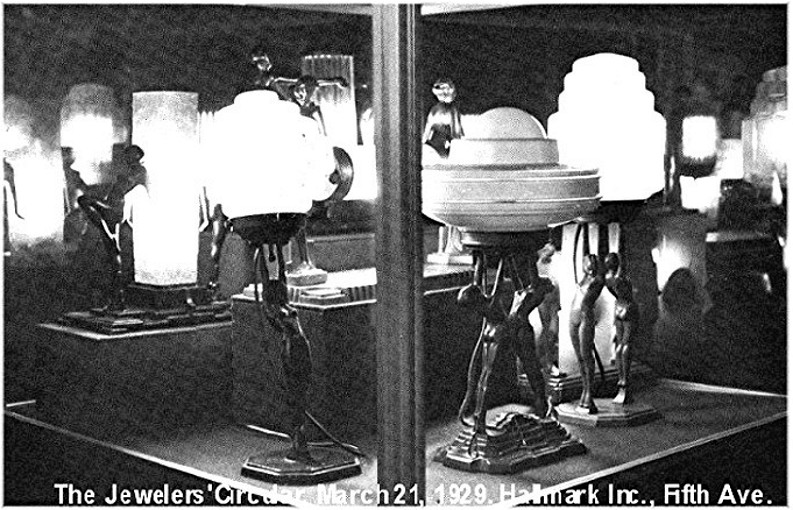|
|
 |
|

|
| Right to left. Betty Beck Co., Crescent Art, Ronson, Nuart Co. and possibly Greist Co. |
As I noted on my “Art
Deco and the 1920’s” page, the Art Deco movement inspired all facets of American lifestyle. Gone were the sentimental
decorations and ghosts of the past. Newspapers, radio, magazines and newsreels opened the world to American audiences,
who found it easier to learn of worldwide news and events.
*
In Egypt, on November
4, 1922, Howard Carter’s workmen found a hidden step near the base of the tomb of Ramses VI. Carter had discovered
not just an unknown ancient Egyptian tomb but one nearly undisturbed for over 3,000 years. It was that of Pharaoh Tutankhamen,
the Boy King. Artists, fashion designers, sculptors and others incorporated this Egyptian influence in their own work.
*
This is very evident in Arthur von Frankenberg’s designs as he added progressions
of stepped-up tiers to the bases of his nymphs. Similarly, other companies providing figural decorative arts such as
Ronson, Betty Beck and Nuart added similar designs to their figural accessories. Not only was Art Deco flexible enough
to incorporate Egyptian motifs but Oriental, African, Mayan, and Native American designs were also used.
frankart@decollector.com
|
 |
According to the “Collector’s
Encyclopedia of Stangl Artware, Lamps, and Birds”, Frankart, Inc. was incorporated in 1922, although it appears Arthur
von Frankenberg began creating his pieces for this new era as early as 1920, according to the copyright information in the
1930-31 Handbook. I am providing below photographs of the figural candleholder called “Flame”, in
which the signature and “1921” can be clearly seen stamped on the piece.

|
 |
As collectors of Frankart nude figural items, we view the partnership
of Arthur von Frankenberg and Frankart, Inc. as forever linked when considering American Art Deco “femme fatale”
statuary. The sculptures designed by Arthur von Frankenberg were never equaled by any of his American contemporaries.
His departure from Frankart, Inc. in the early 1930’s followed the loss of his lawsuit against his partners
Henry Underberg and George Murad. The lawsuit was filed in order for von Frankenberg to take artistic control of
the company.

The
deterioration in the business relationship between von Frankenberg and Underberg can be tracked in the company’s catalogs.
In an early handbook, as well as that for the 1930-31 season, Arthur von Frankenberg was listed as President and director
(or Art Director) of the company. In those two handbooks, Henry Underberg was listed as Vice-president and General Manager;
George Murad was listed as Factory Manager in the 1930-31 Handbook
|
 |
|
However, in the 1932-1933 Handbook, von Frankenberg
was not listed in the catalog, while Henry Underberg was listed as the “Sole Selling Agent”. Also, the 1932-1933
Handbook offered pieces that were not designed by von Frankenberg, including the “Debutante” series designed by
Helene Cross, as well as items designed by Henry Underberg and Max Abel. The patents for their designs all were
assigned to Frankart, Inc. Interestingly, although Arthur von Frankenberg was not listed in the later handbook or supplements
as President or designer of the pieces, he continued to create pieces. According to the patent information, he usually
assigned his earlier patents to Frankart, Inc., although there were a number of items that were not assigned. However,
in mid 1931, von Frankenberg was granted a number of patents for a variety of items, none assigned to Frankart, Inc.
The apparent success of Frankart, Inc. is reflected in the
changes in the product line offered by the company. The early catalog from the 1920’s offered less than
30 items, including four lamps, five candlesticks, and five ash-trays; other items included bookends, incense burners, flower
holders, ink wells and centerpieces. By the 1930-31 season, the Frankart line had dramatically expanded. The handbook
for that season offered over 45 lamps, 18 ashtrays, 13 bookends, as well a broad variety of items that included smokers stands
and smokers sets, an aquarium, clocks, wall plaques, flower vases, and cigarette holders. The Frankart product offering
continued to grow in the subsequent seasons with new models for lamps, bookends, ashtrays and other items.

Frankart, Inc. also expanded its color choices over time.
In the earlier handbook, only three colors were offered – Verde, French and Japanese Bronze. With the 1930-31 handbook,
Gunmetal, “a polished grey”, was added to the color line, and Verde appears to have been renamed “Roman
Green”, that was described as a “light Tiffany green”. Jap was “a very dark brown, almost black…with
green in crevices”, while French was “Brown, with green in the crevices”.
|
 |
In the early years, the main office and display room for Frankart, Inc was located at 1170 Broadway (at 28th Street)
in Manhattan. The studio was at 1947 Broadway in Manhattan while the “wareroom” was at 930 Blake Avenue
in Brooklyn. By the 1930-31 handbook, the company had relocated. The Main Office was now at 225 Fifth Avenue
in Manhattan. The Studio was moved to 33 W. 67th Street in Manhattan, and von Frankenberg was pictured in the new studio
in the handbook. Production now was at a factory located at 542-548 Casanova Street in New York, which according to
Google is located in the Bronx borough. It appears that the locations may have remained through the life of Frankart,
Inc., based on the 1932-33 Handbook, as well as the 1933-1934 and 1935 Supplements.
Frankart items were distributed in both the United States
and internationally, although it appears that the distributors varied. In the early catalog from the 1920’s, the
company noted that it had “representatives” in Los Angeles, New York, Chicago, Portland, Oregon, and in Toronto,
Canada. By 1930-1931, the company now reported that it had distributors in Los Angeles and in London. Frankart
had expanded to Mexico and Argentina by 1932-1933, and added an Australian outlet in the 1935 Supplement.
Although it has been reported
that original molds are still being used to reproduce Frankart replicas, this does not appear to be correct. According
to a couple of sources, the original molds were found and discarded as scrap after the company went out of business.
The present replicas are copies of original Frankart pieces and are cast in a totally different way than the original Frankart
pieces were. When examining any of the newer pieces, it is quite evident that the replicas lack the fine details which
can easily be seen on an original Frankart piece. Not much is known of Arthur von Frankenberg after the early 1930's. It is my hope that in time other collectors
can fill the blanks. This information has been gathered from a number of sources, including articles, Frankart handbooks,
and websites. 
|
|
|
|
|
 |

